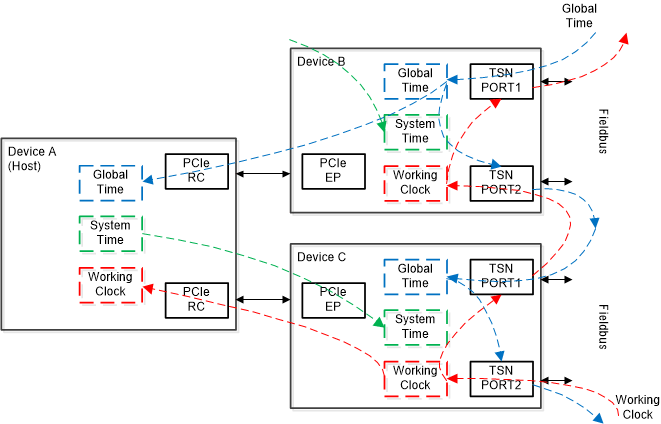SPRACP7 October 2019 AM6526 , AM6528 , AM6546 , AM6548
1 Introduction
In control and automation systems, applications and communications are often required to be synchronized across the network or across devices within the subsystem. Each level of synchronization has its own precision requirements. For example, a cloud-based factory may require its "Wall Clock" to be synchronized via GPS, across its global locations; or a control network may require all devices in the network to be synchronized to a "Working Clock", for time-triggered frame transmissions; or, a subsystem with multiple devices and clock sources will be synchronized to a common time-base, sometimes referred to as "System Time".
Table 1 shows commonly used time synchronization protocols defined on different network interfaces. These protocols govern inter-operatibility of network components when they are implemented. However, when a device supporting multiple types of interfaces is used, the system may require the device to synchronize time-base across these interfaces, hardware architecture support may be needed to facilitate software implementation.
Table 1. Commonly Used Time-Synchronization Protocols
| Description | Released | Best Achievable Accuracy | Applications | TI Devices | |
|---|---|---|---|---|---|
| GPS | GPS Satellites | --- | 100 µs-1 ms | Wire- and wireless networks | --- |
| IETF NTP | Network Time Protocol | 1985 | Tens of Milliseconds<1ms LAN | Internet | Software |
| IEEE 1588 2002 | Precision Time Protocol | 2002 | <1 µs | LAN | K2H, K2L, AM3x/4x/5x, AM65x |
| IEEE 1588v2 | Precision Time Protocol V2 | 2008 | <1 ns | LAN | K2H, K2L, AM3x/4x/5x, AM65x |
| IEEE 802.1AS | Timing and Synchronization for Time-Sensitive Applications in Bridged Local Area Networks | 2011 | <1 ns | LAN | K2H, K2L, AM3x/4x/5x, AM65x |
| PCIE PTM | Precision Time Measurement | 2013 | 1 ns | Real-time system clock synchronization | AM65x |
| SyncE | Synchronous Ethernet | ~2010 | 0.01 PPM | Wireless etc | K2H, K2L |
| SyncR (TI internal naming) | Synchronous Radio I/F (CPRI) | --- | --- | Wireless | K2L |
Figure 1 shows a simplified control module, where three controller devices are deployed. Device A is the host where Devices B and C are connected to it via PCIe ports. Device B and C are network interface cards that is connected to A. Additionally, Device B connects to a GPS receiver that sends out a pulse train for the Global Time (Wall Clock). Device C receives a Working Clock via the IEEE 802.1AS protocol. In later sections of this document, it is described how these three types of time-bases are maintained for the network, based on AM65xx time sync architecture.
 Figure 1. Example of a Control Module With Multiple Time Bases
Figure 1. Example of a Control Module With Multiple Time Bases